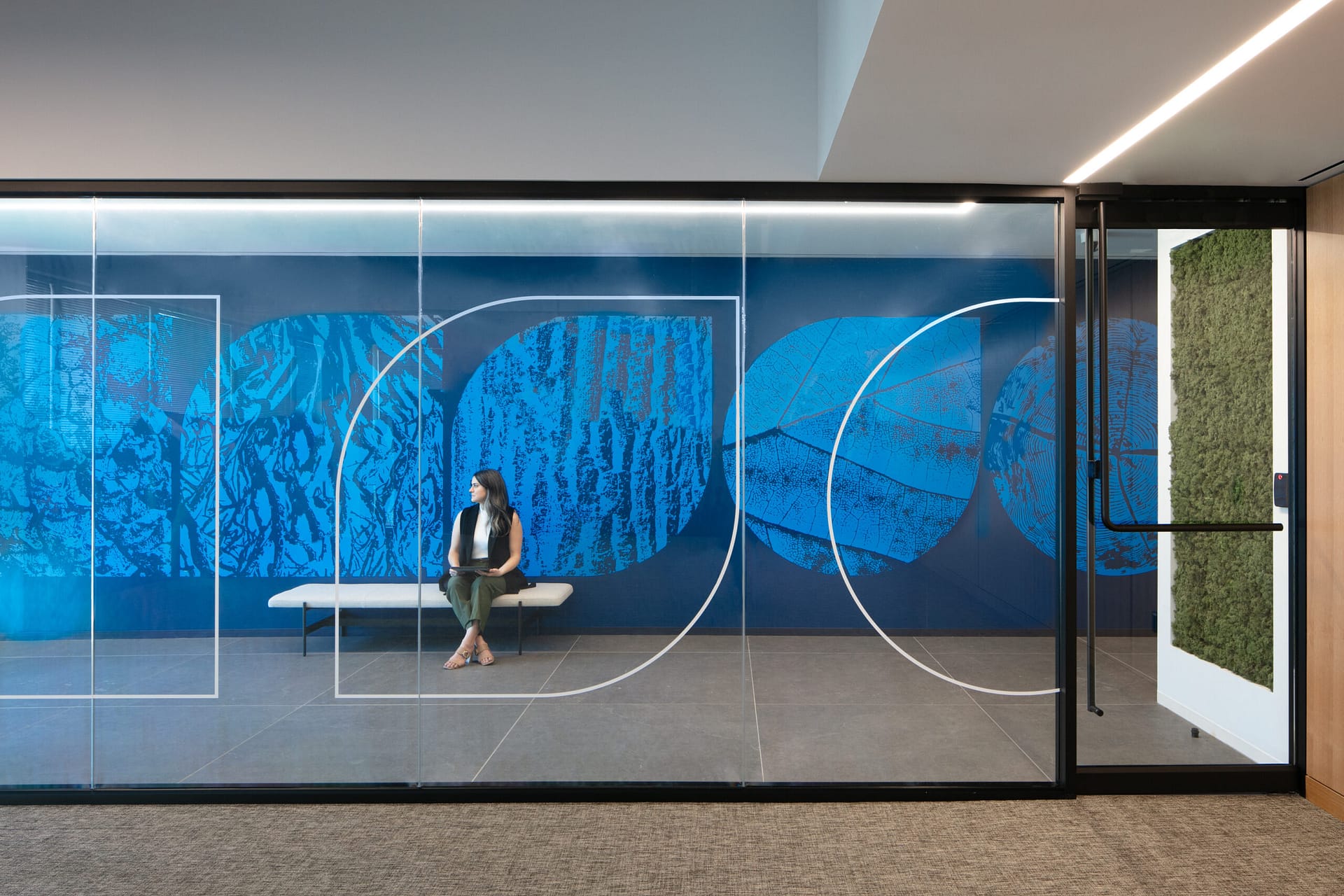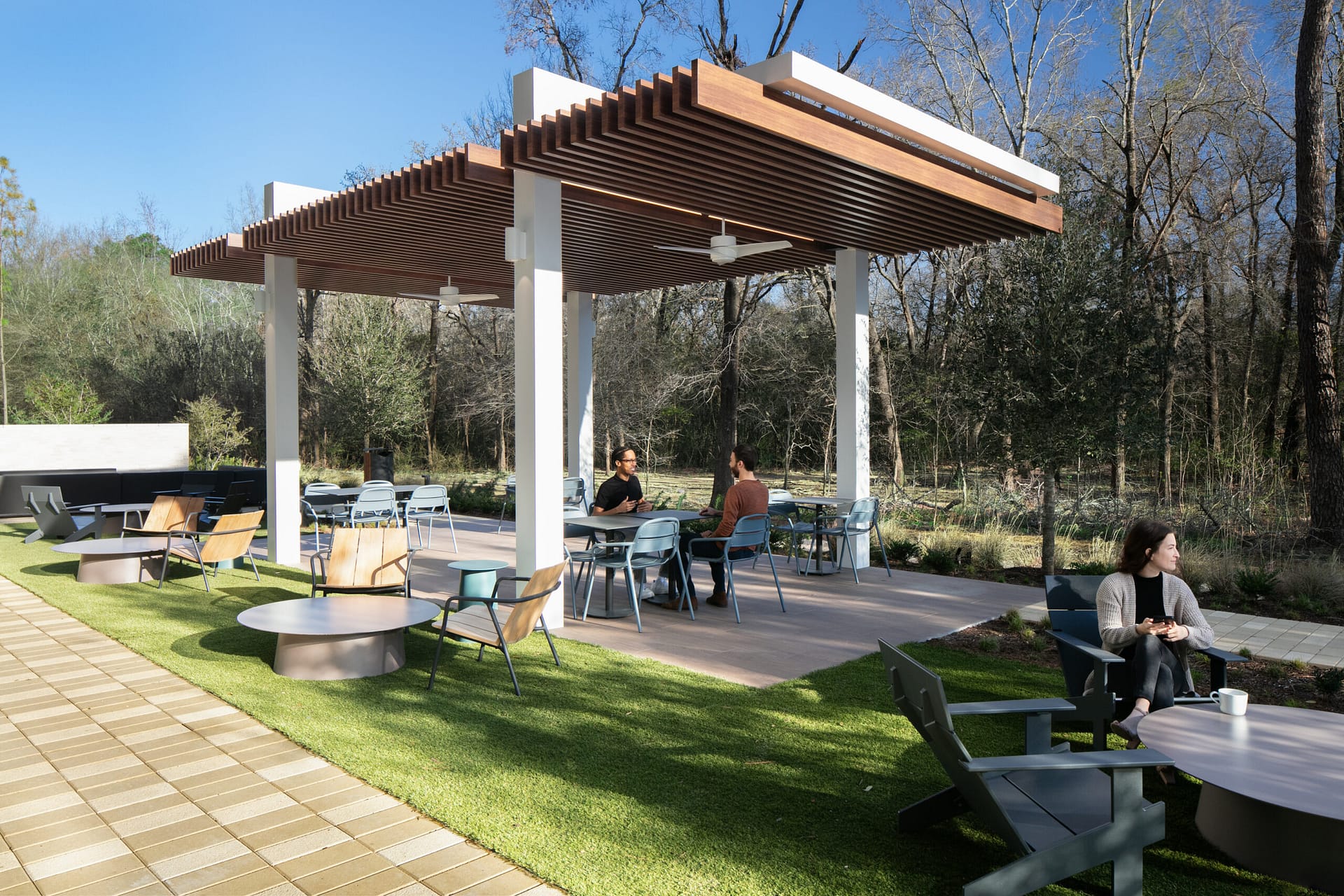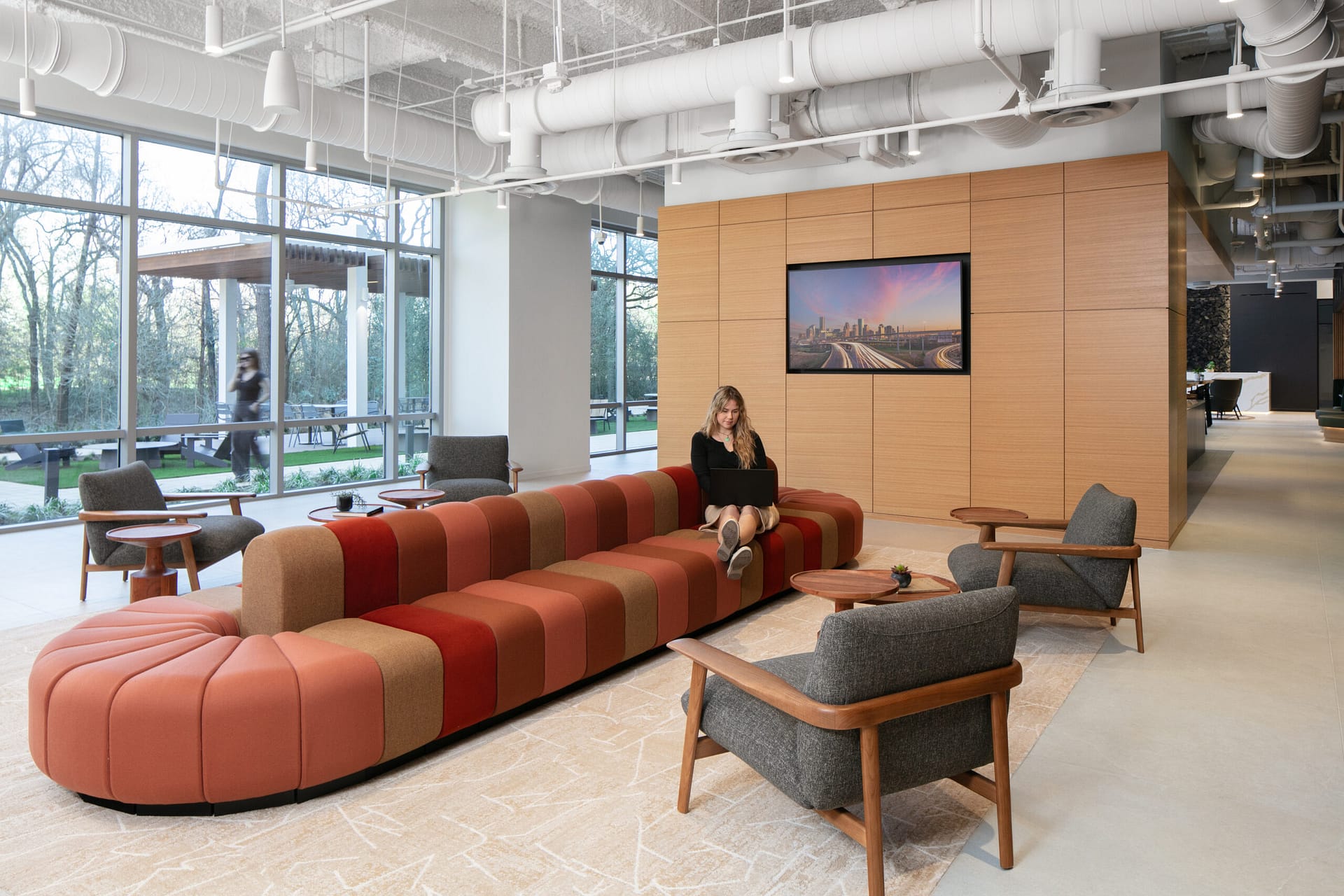
By Kim Parsley, LEED AP | Managing Principal
&
Troy Christie | Space Matrix | Director
We recently sat down with Managing Principal Kim Parsley of IA Interior Architects and Director Troy Christie of Space Matrix for a Q&A to learn about the evolution and innovations being developed by this strategic partnership. With Space Matrix celebrating its 20th anniversary this year and IA its 37th, we wanted to know if the extensive experience and success of these two firms individually has made the difference anticipated by the formation of the IA Space Matrix partnership. As head of the IA Space Matrix studio and the single point of contact for partnership clients at their respective firms, Kim and Troy steer global projects across APAC, the Americas, and EMEA. When the two firms first explored the idea of a partnership, geographic location was a major consideration. Both companies have carved out a niche and reputation for excellence in the regions where they operate, delivering projects across the globe for years. In addition, the ongoing pursuit of better ways to work and serve clients, a key trait of both firms, made the possibility of working together to create a truly global service for clients very compelling.
What inspired the IA Space Matrix partnership?
TC: For Space Matrix it meant enhancing our offerings in America. IA has a strong presence in North America, and that’s certainly a market where a majority of our clients are based. So, it made a lot of sense for us to come together and create a unique global service
KP: For IA too, this partnership had huge global potential. Space Matrix’s reach and geographic capabilities in APAC were quite impressive. Being able to partner with a single firm for all of our work in Asia Pacific was extremely attractive and would enable us to build a combined expertise and grow our competence and confidence as a consistent team.
How did global operations for each firm work before the partnership?
KP: Since both Space Matrix and IA had been working with clients around the world for years, each had honed its own strategy to serve clients across global geographies. IA had multiple partners worldwide, and several senior-level IA professionals were responsible for the interaction and management of those relationships, which we successfully leveraged in delivering projects for clients. But over time as the complexity of doing business internationally became more apparent, it was clear that we needed to evolve our strategy. It was a challenge to maintain consistent partnerships given the unstable market conditions in some countries, and the vigilant vetting required to make sure the firms selected could maintain financial viability. IA clearly recognized the advantages of building a consistent relationship with a single firm whose values and traits were aligned with our own. Now, with Troy and I, each firm has identified a single point of global contact which creates an extremely efficient and streamlined approach to supporting our clients.
TC: Space Matrix teams were also identifying how best to deliver the nuances of global projects. Local service and presence are a big part of global delivery. We had one-off opportunities in different U.S. cities which were challenging given that each market is different. So, for the long term, a relationship-driven platform made a lot of sense. And we have been able to reduce any duplication of efforts through clear and consistent protocols—the partnership has created that opportunity.
What makes the IA Space Matrix partnership unique?
Troy and Kim agree that similarities between the two firms were key factors and that the CEOs of both firms played a significant role in bringing the firms together. Aside from envisioning the growth potential and client advantages, they laid the groundwork to align the partnership’s shared values and beliefs. For instance, both firms have specialized international teams complemented by years of experience in their respective regions. Both are focused on interiors and are highly invested in technology and innovation. Moreover, the diversity of tools and services that each firm brings to the table is something unique.
KP: It’s remarkable how well aligned our professionals truly are. They share a common language of design—common, but not exactly the same, and that’s what makes this relationship so powerful because diverse points of view create amazingly designed projects.
How does the IA Space Matrix partnership meet and anticipate client needs?
On this point, Troy alludes to the analogy that one size doesn’t fit all and how the partnership has proved to be a strength in diverse scenarios.
TC: Our mutual client, a technology company, based in Seattle, wanted a local team in Hyderabad where the project was located. IA had already completed several projects for them, and when this international project was triggered, IA, with its knowledge of the client, seamlessly coordinated with Space Matrix’s India team to collaborate on the project’s successful completion. Since we had already established inter-firm protocols related to technology, project management, and design approach, there was very little on-boarding needed.
In a reverse scenario, another client based in India wanted a single point of contact in Mumbai, although the project was going to be in Dallas, Texas. Being able to reach out to the IA studio in Dallas to provide services locally, while we maintained client management with a single point of contact and a local presence, was unique and exactly what was needed. Every client presents a very individual set of circumstances, and the partnership comes with a huge toolset that enables us to customize solutions.
How does the partnership’s wider reach benefit global clients?
KP: Apart from driving immense advantages for one-off projects, the partnership offers massive benefits to clients who have a global presence. These clients’ real estate teams were getting leaner before the pandemic and are still lean now, as we continue to feel the effects of the pandemic. In this environment, each new project involves a lot of extra client effort. For a global client, having to onboard, train, and explain their goals and preferences every time they hire a different firm in a new location involves a lot of heavy lifting in terms of time, cost, and effort. Our ability to apply consistent processes and make knowledge transference more seamless to ensure project efficiency helps clients avoid reinventing the wheel—that’s been a powerful solution for our clients. We’ve been able to offer global magnitude with local aptitude. If clients are looking for design expertise in a given location that aligns best with their time zone or their real estate team, it is easily accommodated. Or if they are looking for local knowledge on regulations and codes or means and methods of construction, we have the expertise in all their locations.
How agile are the teams within the partnership?
As an example, Kim and Troy delve into how the partnership itself had to be agile to stay relevant in response to the pandemic. Since the relationship was still in its early days when the world shut down, the roadmap initially envisioned had to be altered drastically.
KP: As an introduction to the new partnership, plans had been made for a roadshow across the U.S. to engage with key clients, but that eventually became a virtual event. While organizations paused or postponed their real estate projects and priorities to address the pandemic, we took the opportunity as partners to bring together our in-house experts and discuss, research, and explore subject matters relevant to the workplace and its evolution. This led to the development of several whitepapers, surveys, and other research. We not only developed diverse insights for our industry, which was undergoing rapid change, but had the opportunity for our two teams to learn from one another and diversify their design thinking and approach.
TC: Since many companies are looking to industry experts for guidance to navigate their way through the current world of work and plan their strategy based on what the global workplace might look like in the future, our combined thought leadership has been valuable to our clients during the pandemic. Our joint survey is a good example. Looking at what our clients in APAC are telling us and comparing that to what clients are saying in North America offered some powerful metrics, and a lot of clients appreciated those insights.
How easily did the firms’ two cultures come together?
TC: Forming such a global partnership comes with its own set of challenges. It’s been important to manage expectations around 24-hour availability. Once, when we set a meeting for the 23rd and 24th of the month that turned out to be the same day in Seattle! Kim’s subsequent recommendation of an international meeting planner is now an app we all use daily, making it much easier to organize meetings between four or five time zones. Also, while there are certain advantages to having a team spread across multiple time zones to quicken project progress, we quickly learned to leave time for peer reviews and collaboration, which is very important to ensure consistency.
The clients are the winners here, because they are now able to leverage a wider range of services.
– Troy Christie | Space Matrix | Director
What has been the relevance of technology to the partnership?
TC: To push each other’s boundaries for innovation has been significant. To be able to bounce ideas and prototypes off design experts from around the world has led to an extensive suite of exciting innovations. The clients are the winners here because they are now able to leverage a wider range of services.
KP: The partnership has been extremely valuable on the technological front. Even during the pandemic, both firms have been launching new innovations; for example, Space Matrix implemented SpaceDX (which helps companies visualize social distancing and plan for capacity and space requirements), and I think that’s exactly what many of our global clients have been searching for. We can learn from that. And Space Matrix was inspired by IA’s Techni innovations, such as Quanta, the Harbor@work app, and our multiple VR applications.
How has architecture and interiors consultation changed during COVID?
KP: While visioning the future of work has been a constant theme since the industrial revolution, following the pandemic, exploring what the future of work looks like has required an entirely new lens for real estate leads, and it looks different in India versus Singapore versus the US. Overall, clients are becoming more sophisticated and organized in terms of the value of global guidelines and standards. Being a global partnership has well-positioned our two firms to help clients navigate not only the approach to delivering the workplace internationally but how to layer in and address the challenges created by the pandemic. Being able to offer a global level of design intelligence, particularly to our clients who have a global real estate purview, continues to be our combined strength.
TC: Our joint teams help clients understand best practices in products, metrics, and methods of construction depending on the global location of each project, including the impacts of codes and regulations and the requirements of different markets in a post-pandemic scenario.
We have proved that remote working is possible, although the physical workplace continues to be relevant today as the ideal option offering the sense of community and camaraderie that is fundamental to a company’s culture and continued innovation.
-Kim Parsley | Managing Principal
What is the IA Space Matrix vision for the future?
KP: It took a global pandemic to rethink the workplace—a change much needed for a very long time. During the ongoing pandemic, many big companies claimed they would only work remotely in the future. But now that the impacts of working from home for long periods are better understood, many companies are taking a step back and considering a model that gives them more options. We have proved that remote working is possible, although the physical workplace continues to be relevant today as the ideal option offering the sense of community and camaraderie that is fundamental to a company’s culture and continued innovation.
TC: Our partnership, formed during the pandemic, has fast-tracked the speed of innovation. On an individual level, you see immense growth in designers and a creative response that has enabled them to work outside the one city they were used to working in and to really grow. This provides more value—both internal and external.
Troy and Kim agree that the partnership’s knowledge sharing and openness, accelerated by the pandemic, is being leveraged to create greater benefits for their clients. And most importantly, bringing the partnership’s 1,400 combined colleagues together, each with a diverse point of view on design and delivery, has proved invaluable, not only to strengthen the partnership but to take it to new levels of expertise.
Contact Kim or Troy to discuss your global workplace requirements and tap into IA Space Matrix’s expertise.







